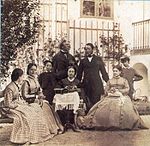Rolighed (Østerbro)

Rolighed was a country house in what is now the Østerbro district of Copenhagen. As a regular guest of the Melchior family, Hans Christian Andersen died there in August 1875.[1]
History[edit]
Origins[edit]
Rolighed (the Danish word means "tranquility" or "calmness") built around 1800 as a one-storey house with a mansard roof in a large garden. The property was for a while owned by the military officer Johan Hendrik Hegermann-Lindencrone (1765–1849) and his wife Louise Hegermann-Lindencrone. They were known for hosting literary salons attended by some of the leading cultural figures of the Danish Golden Age.[2] Johan Hendrik Hegermann-Lindencrone died at Rolighed in 1849.
Melchior family and Hans Christian Andersen[edit]
Jewish merchant Moritz G. Melchior and his wife Dorothea acquired it as a summer residence in the 1850s. In 1869, they had it completely rebuilt in the Dutch Renaissance or Christian IV style of Rosenborg Castle with a tower and rounded Dutch gables.[3]

Moritz and Dorothea Melchior entertained a variety of famous guests from the late 1850s when the family business really began to prosper. The most famous of these were certainly Hans Christian Andersen who was a frequent visitor, first in their home on Højbro Plads then increasingly at Rolighed where, in 1866, he was given his own room with a balcony overlooking the Øresund.[3]
Moritz' brother Israel, a keen amateur photographer, was also a frequent visitor. Andersen, who was interested in photography himself, and he became good friends with the result that Israel took many photographs of family gatherings at Rolighed together with Andersen.[4][5]
Andersen had become increasingly ill after a fall in 1872. He relied increasingly on the care the Melchiors gave him, spending long periods at Rolighed. On 12 June 1875, he arrived there for the last time. A week later he was no longer able to write his diary which instead he dictated to the Melchiors and their children. At 11 a.m. on 4 August, he died peacefully in his bed.[3]
Commemorative plaque[edit]
The house was demolished in 1898 to be replaced by today's apartment building. A plaque has been erected, commemorating Andersen's place of death. It contains two lines from a short poem by Andersen, testifying to his feelings for Rolighed:[6][7]
- Mit hjem i Hjemmet, hvor bag Hyldens Hang
- mit Liv fik Solskin og min Harpe Klang
which can be translated into English as:
- My home in the home, behind the elderflower
- Gave sunshine to my life and made my harp ring
See also[edit]
References[edit]
This article draws on the Danish Wikipedia article Rolighed (Østerbro).
- ^ "Hans Christian Andersen – FAQ", Hans Christian Andersen Center. Retrieved 10 December 2010.
- ^ Busk-Jensen, Lise (2003). "Louise Hegermann-Lindencrone (1778 - 1853)" (in Danish). Kvinfo. Retrieved 6 September 2021.
- ^ a b c Carl H. Melchior, "H.C. Andersens hjem i hjemmet - artikel fra Jødisk Orientering, marts 2005", Kulturafdelingen: H.C. Andersen 2005, Israeli Embassy, Copenhagen. (in Danish) Retrieved 9 December 2010.
- ^ "I Was Posing for The Photographer Today - Twenty Portraits of H.C. Andersen" Archived 2010-11-07 at the Wayback Machine, Odense City Museums. Retrieved 10 December 2010.
- ^ Nicolaj Bøgh, "H.C. Andersens sidste dage" Archived 2011-07-18 at the Wayback Machine, H.C. Andersen Information. (in Danish) Retrieved 10 December 2010.
- ^ Ane Grum-Schwensen, "Thank You for the Letters You Sent Me…", Odense City Museums. Retrieved 11 December 2010.
- ^ "Mindetavler på Østerbro", Københavns Biblioteker. (in Danish) Retrieved 11 December 2010.
